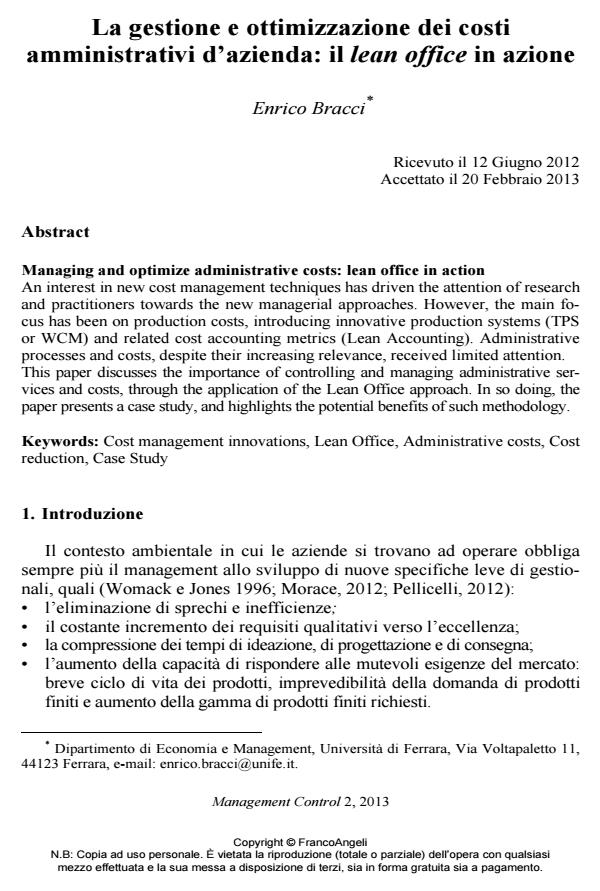Managing and optimize administrative costs: lean office in action
Journal title MANAGEMENT CONTROL
Author/s Enrico Bracci
Publishing Year 2013 Issue 2013/2
Language Italian Pages 20 P. 67-86 File size 703 KB
DOI 10.3280/MACO2013-002004
DOI is like a bar code for intellectual property: to have more infomation
click here
Below, you can see the article first page
If you want to buy this article in PDF format, you can do it, following the instructions to buy download credits

FrancoAngeli is member of Publishers International Linking Association, Inc (PILA), a not-for-profit association which run the CrossRef service enabling links to and from online scholarly content.
An interest in new cost management techniques has driven the attention of research and practitioners towards the new managerial approaches. However, the main focus has been on production costs, introducing innovative production systems (TPS or WCM) and related cost accounting metrics (Lean Accounting). Administrative processes and costs, despite their increasing relevance, received limited attention. This paper discusses the importance of controlling and managing administrative services and costs, through the application of the Lean Office approach. In so doing, the paper presents a case study, and highlights the potential benefits of such methodology.
Keywords: Cost management innovations, Lean Office, Administrative costs, Cost reduction, Case Study
- AME (2007), Lean Administration: case studies in leadership and improvement, New York, Productivity Press.
- Anthony L.R., Hawkins D.F., Macrì D.M. (2007), Sistemi di controllo, Milano, McGraw-Hill.
- Atzeni P., Batini C., Casati F., Pernici B., Saladini L. (2001), Modelli e Progettazione, in Batini C., Pernici B., Santucci G. (a cura di), Sistemi informativi. Vol. II, Milano, FrancoAngeli.
- Chiarini A. (2010), Lean organisation for excellence, Milano, FrancoAngeli.
- Davenport T. H. (1993), Process Innovation. Reengineering work trough Information Technology, Harvard Business School Press.
- Drucker, P (1999), Le sfide del Management del XXI Secolo, Milano, FrancoAngeli.
- Farneti G., Silvi R. (1997), L’analisi e la determinazione dei costi nell’economia delle aziende, Torino, Giappichelli.
- George M. (2006), Lean Six Sigma per i servizi. Ridurre i costi migliorare la qualità dei servizi in meno di un anno, tr. it. Olmo, Milano, Guerini e Associati.
- Graziadei G. (2006). Lean manufacturing: come analizzare il flusso del valore per individuare ed eliminare gli sprechi”, Milano, Hoepli.
- Keyte B., Locher D. (2004), The complete lean enterprise: value stream mapping for administrative and office processes, New York, Productivity pres.
- Liker J., (2004), The Toyota Way, McGraw-Hill Professional.
- Louis R. S., (2007), Creating the ultimate lean office: a zero-waste environment with process automation, New York, Productivity Press.
- Marasca S., Silvi R., (2003), (a cura di), Sistemi di controllo e cost management. Tra teoria e prassi, Torino, Giappichelli.
- Marchi L. (2011), L’evoluzione del controllo di gestione nella prospettiva informativa e gestionale esterna, Management Control, 1, 3.
- McNeill P. (1990) Research Methods, 2nd ed., London, Routledge.
- Morace F. (2011), I paradigmi del futuro. Lo scenario dei trend, Nomos.
- Negro G. (2005), L’organizzazione snella nella pubblica amministrazione. Come realizzare la «lean organization» negli enti pubblici, Milano, FrancoAngeli.
- Negro G., Ozzello S. (2010), Le soluzioni snelle per la P.A.: come tradurre il nuovo modello organizzativo “lean government” in soluzioni concrete ed efficaci, Rimini, Maggioli Editore.
- Ohno T. (1988), Toyota Production System: Beyond Large-Scale Production, New York, Productivity Press.
- Pellicelli G. (2010), Strategia d’impresa, terza ed., Milano, Egea.
- Silvi R., McNair CJ., Polutnik L. (2001), Cost management and value creation: the missing link, The European Accounting Review.
- Tapping D. (2006), Lean office demystified: using the power of the toyota production system in your administrative areas, MCS Media.
- Tapping D. (2009), The new Lean Office training set, Kindle Edition.
- Tapping D., Shuker T. (2002), Value stream management for the lean office, Kindle Edition.
- Thompson J. (1997), The lean office: how to use just-in-time techniques to streamline your office, Toronto, Productive Publications.
- Venegas C. (2007), Flow in the office: implementing and sustaining lean improvement, New York, Productivity press.
- Womack J P., Jones D. T. (1996), Lean thinking. Come creare valore e bandire gli sprechi, tr. It. Poli Edizione 2, Guerini e Associati, 2000.
- Rendicontare l'impatto sociale. Metodologie, indicatori e tre casi di sperimentazione in Toscana Marco Bellucci, Carmela Nitti, Chiara Chimirri, Luca Bagnoli, in MANAGEMENT CONTROL 3/2019 pp.166
DOI: 10.3280/MACO2019-003009
Enrico Bracci, La gestione e ottimizzazione dei costi amministrativi d’azienda: il lean office in azione in "MANAGEMENT CONTROL" 2/2013, pp 67-86, DOI: 10.3280/MACO2013-002004